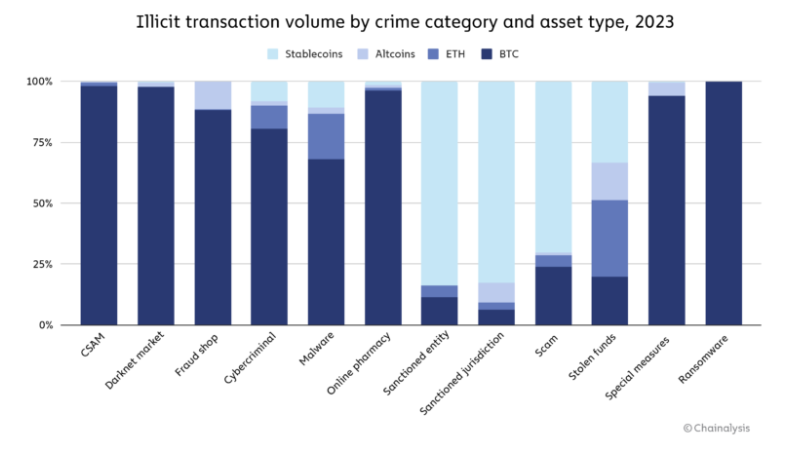- Scamming and stolen funds decrease; ransomware and darknet markets see revenue increases.
- Stablecoins surpass Bitcoin as the preferred currency for illicit transactions due to stability and ease of use.
- Chainalysis reports a 39% drop in total crypto value sent to illicit addresses from $39.6B in 2022 to $24.2B in 2023.
Fears of rampant cryptocurrency-fueled crime may be cooling, as a new report from blockchain data platform Chainalysis reveals a significant drop in crypto value received by illicit addresses throughout 2023.

Total cryptocurrency value received by illicit addresses, 2018-2023
The report reveals a 39% drop in the total value sent to illicit addresses, from a staggering $39.6 billion in 2022 to just $24.2 billion last year. This decrease was accompanied by a dip in the share of all crypto transaction volume associated with illicit activity, down from 0.42% to 0.34%.
The report also highlights a changing landscape of crypto-based crime, with stablecoins now dethroning Bitcoin, once the go-to currency for cybercriminals, as the preferred currency for illicit transactions. This popularity can be attributed to its inherent stability and relative ease of use.

Illicit transaction volume by crime category and asset type, 2023
However, the dominance of stablecoins varies depending on the type of crime. Bitcoin remains the primary currency for darknet market sales and ransomware extortion, while scams and transactions linked to sanctioned entities gravitate towards stablecoins. Notably, these crimes related to stablecoin activities happen to be the biggest forms of crypto crime by transaction volume.
The biggest declines were seen in scamming and stolen funds, down by nearly 30% and 50%, respectively. However, despite the overall decline in crypto crime, ransomware and darknet markets bucked the trend, seeing their revenues rise in 2023. Perhaps the most surprising finding is the dominance of sanctions-related transactions, which account for over 60% of all illicit activity.
While this decrease offers a welcome reprieve, the report cautions against interpreting it as a victory lap. Chainalysis emphasizes that these figures are “lower bound estimates,” meaning the true scope of crypto-crime is likely higher due to the constant discovery of new illicit addresses.
Disclaimer: The information presented in this article is for informational and educational purposes only. The article does not constitute financial advice or advice of any kind. Coin Edition is not responsible for any losses incurred as a result of the utilization of content, products, or services mentioned. Readers are advised to exercise caution before taking any action related to the company.










